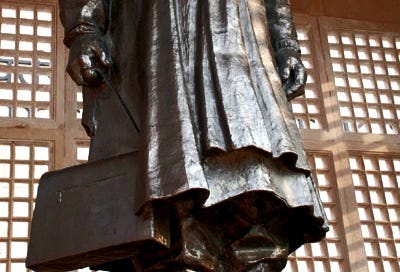Welcome to the Brown History Newsletter. If you’re enjoying this labor of love, please do consider becoming a paid subscriber. Your contribution would help pay the writers and illustrators and support this weekly publication. If you like to submit a writing piece, please send me a pitch by email at brownhistory1947@gmail.com.
Don’t forget to check out our SHOP and our Podcast.

Recommended Reads:
A Statue with a Handbag: A symbol for emancipation, but for whom?
In the 20th century, handbags entered the mainstream fashion industry as one of the most preferred accessories. They evolved from being purely practical items to symbols of the women's class and status in society. The designs, materials, prices, and notably, the brand names of purses and handbags became as, if not more, as significant as the bags' practicality. They hold a special place in the women's closet and they are the first accessory that women look for when leaving their house. They are a piece of women’s private sphere that she flaunts in the public sphere, allowing women to navigate themselves in public spaces independently. Thus, serving as an emancipatory symbol. But they are not merely considered as a container for personal belongings. They go beyond being just another article of an accessory or a symbol of emancipation.
Bags are carried by women belonging to different classes and castes, bearing witness to varied lived experiences. It highlights the complexities of contemporary society while being trendy. Moreover, the different roles of handbags in the private and public spheres as well as their shared space explores many facets of social realities. Perhaps, to demonstrate this or rather to open the possibilities and potentialities of handbags, the former Chief Minister of Uttar Pradesh, India, Mayawati, built numerous statues of herself adorning leather handbags.
Kumari Mayawati, a Dalit (lower-caste) woman, served as the chief minister of Uttar Pradesh, India, intermittently between the years 1995-2012. Her tenure made a historic milestone in Indian history as she was the first Dalit woman who managed to reach such a high level of governance. During her fourth term (2007-2012), she engaged herself in the massive and extravagant construction of statutes. These statues often depicted her in short hair, in salwar-kameez (typical Indian attire), and prominently featured her holding a leather handbag.







